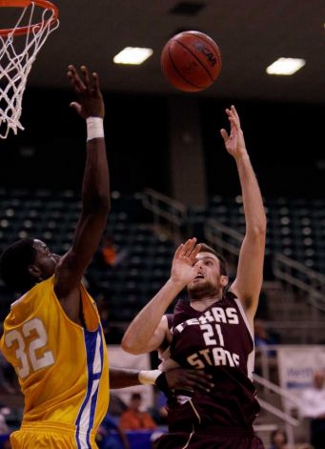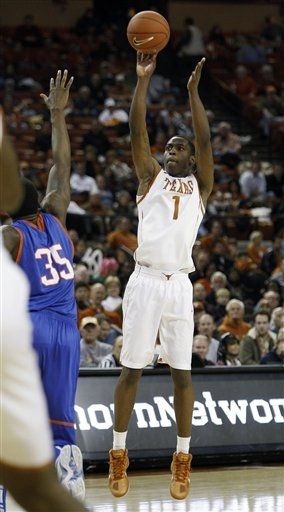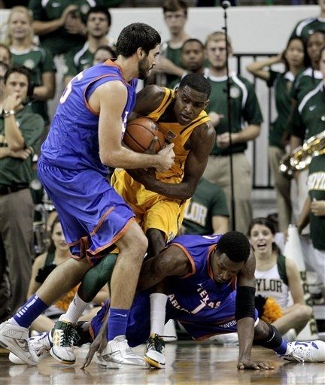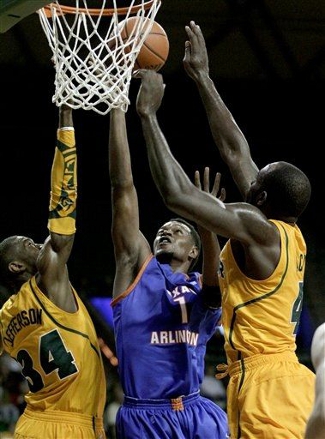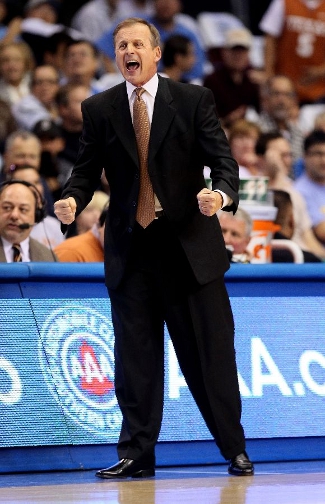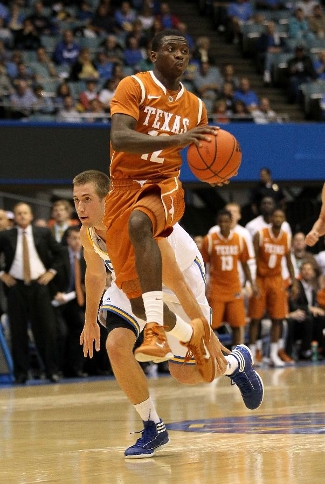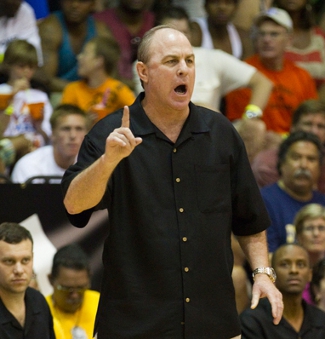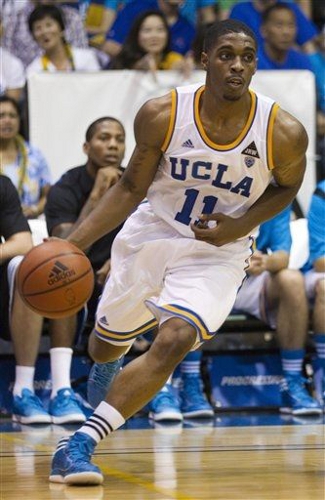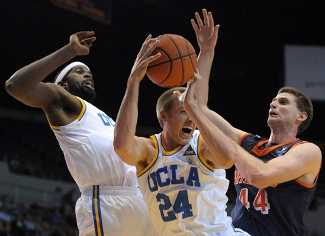Frank Erwin Center | Austin, TX | Tip: 7 P.M. CT | TV: Longhorn Network LRT Consecutive Game #195 The Texas Longhorns are back in action tonight as they renew their annual rivalry with nearby Texas State at the Frank Erwin Center. This is the 46th all-time meeting on the hardwood between these two schools, and this marks the eighth-straight year they have squared off. Texas has defeated Texas State a whopping 40 out of 45 times, with their last defeat coming all the way back in the 1937-38 season. The Longhorns looked good in their last outing, riding the hot hand of freshman Sheldon McClellan to an 18-point win over UT-Arlington. Texas had five players in double-digit scoring and sank more than 48% of their shots from the field in the victory. Fans can look forward to even more offense tonight as the Longhorns squeeze in another tune-up before tougher non-conference tests at the end of the month. By the numbers Once again, Texas State is one of the fastest five teams in the country, an honor the team has held in each of Coach Doug Davalos’ first five seasons in San Marcos. The Bobcats actually played at the fastest tempo in all of Division-I basketball during the 2007-08 season, averaging more than 80 possessions per game. Although that number is incredible in its own right, it’s even more ridiculous that the Longhorns and Bobcats have averaged 81.2 possessions in their five match-ups since Davalos took over. 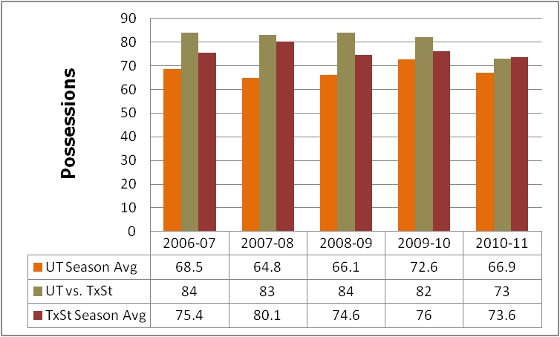 Last year, the Bobcats had a hard time scoring the ball. This year, their offense has improved slightly, but now their defense is one of the absolute worst in the country. Texas State is allowing 1.094 points per possession, a number that only puts them ahead of 16 other D-I schools in that department. The Bobcats have one of the 25 worst free-throw rates in D-I, allowing their opponents one free throw for every two field goal attempts. Of course, they are also allowing opponents to knock down 40% of their threes and almost 45% of their shots, so perhaps allowing other teams to beat them one point at a time might not seem so bad in comparison. Texas fans will like the fact that Texas State is one of the worst offensive rebounding teams in the country. The Longhorns have been equally bad on the defensive glass, so the rebounding battle on that end of the floor will be interesting. One would think that the bigger Texas frontcourt would be able to exploit their size advantage, but that hasn’t been the case so far this season against smaller teams. Those poor offensive rebounding numbers are really killing the Bobcat offense, which is actually shooting at a 47% clip and is making 40% of their threes. Texas State is also controlling the ball very well, turning it over on just 16.6% of their possessions. That number is just outside of the Top 20 nationally, but it is even more remarkable when you remember just how fast they play the game. If Texas State could actually reclaim some of their missed shots, the offense would be incredibly efficient. Meet the Bobcats As is the case every year, Coach Davalos has a very deep bench that he uses liberally to keep fresh legs on the court. Nine different Bobcats average more than 14 minutes a game, with another four players on the bench averaging between seven and nine. If this game is played at the breakneck speed of the last five meetings, there is no doubt that the smaller Longhorn rotation is going to be gassed down the stretch. Although the Bobcats have a true ensemble cast, the one word that best describes the team is young. Texas State lost five of the top six scorers from last year’s team, meaning that just 35.3% of the team’s scoring returned this season. While the Longhorns are certainly in a similar situation, the newcomers on the Texas State sideline are just a tad less heralded than those Rick Barnes has brought on board.
Matt Staff is Texas State’s leading scorer this season Fortunately for the Bobcats, junior Matt Staff (No. 21) has stepped up in a big way this season. A transfer from the University of New Mexico, Staff didn’t see much playing time in his first year at Texas State, as then-seniors Tony Bishop and Cameron Johnson were the unquestioned leaders. This year, however, he’s playing nearly 20 minutes a game and leads the team with a 12.9 scoring average. Coach Davalos has said that Staff is a good shooter who can work the pick-and-pop, but he’s done most of his work inside so far this season. Staff is also tops on the team in rebounding by a wide margin. He is averaging 7.6 rebounds, including three per game on the offensive end. Guard Travis Jones has the next-best mark for the Bobcats, and he has only pulled down 4.4 boards per game. Senior Eddie Rios (No. 11) has also become a leader this season, and is right on the heels of Staff in the scoring race. Averaging 12.8 points per game, the former Miami Hurricane is also averaging just over three assists per game and has made nearly 42% of his three-point attempts. Rios didn’t play when the teams met last season, but he did log 10 minutes and three points when Miami played Texas in the second round of the 2008 NCAA Tournament. Senior guard John Bowman (No. 5) is the only returning player who started against the Longhorns last season, one of 32 starts he earned during his junior campaign. This year, he is averaging over seven points and roughly 20 minutes of action per game. He is the best on-ball defender for the Bobcats, so it’s very likely that the 6’4″ guard will be tasked with shutting down J’Covan Brown. On the wing, Brooks Ybarra (No. 2) is having a solid start to his senior year. He is averaging more than 11 points per game and has made almost 47% of his looks from behind the arc. Those are impressive numbers for a guy who is a former walk-on. Ybarra is also bringing the effort on the defensive end, a big reason why he’s started seven of the team’s eight games so far. Sophomore Reid Koenen (No. 3) has really upped his numbers from his freshman season, raising his scoring average from just one point per game to nearly eight this year. He’s also increased his rebounding numbers exponentially, improving from 0.4 boards per game last year to just a shade under three this year. Koenen actually had one of the best games of his season against the Longhorns last year, scoring five points in eight minutes. Senior guard Travis Jones (No. 15) also had a good game against Texas last year, knocking down 3-of-5 from behind the arc. This season, he’s had even more success from long range, sinking more than 54% of his three-point attempts. As we mentioned above, Jones has improved his rebounding in his senior year, ascending to the second spot in the team rankings. He’s also a good perimeter defender who will try to make life difficult for the Longhorn guards. Freshman Nick Hinton (No. 44) has made an immediate impact, even earning a start in his collegiate debut against USC-Upstate. In his second game, Hinton exploded for 12 points and six boards against UT-Pan American, but he has found less playing time over the team’s last three games. Junior guard Travonn (Vonn) Jones (No. 1) is a JUCO transfer from Lamar State in Pennsylvania, and his experience gives Coach Davalos even more flexibility in the backcourt. Despite being just 5’11”, Jones can play both the one and the two, and leads the team with nearly four assists per game despite coming off the bench all season. Freshman Wesley Davis (No. 10) is the final member of Texas State’s core rotation, and he’s averaging almost 16 minutes per game. He’s an athletic guard with a great shot who is going to be integral to the success of the Bobcats when they move to the WAC next season. For now, he provides an excellent scoring option off the bench, shooting nearly 53% from the field and 40% from behind the arc. Keys to the game 1) Defend the three-point line – The Bobcats are an excellent match-up for the Longhorns, but the long-range shot is the great equalizer in most upsets. Texas State has made 40% of its three-pointers on the year, including an impressive 44.6% mark against D-I opponents. While the Bobcats will likely have a very tough time hanging with Texas tonight, a scoring barrage from behind the arc would certainly make things interesting. 2) Win the rebounding battle – For the first few weeks of the season, we’ve simply been hoping that the Longhorns can be competitive on the glass. Tonight, they should finally be able to post some solid rebounding numbers. The main struggle for the Longhorns has been ending defensive possessions by securing the rebound, but fortunately the Bobcats have had their own problems reclaiming the offensive boards. If the Longhorns still can’t grab defensive rebounds against Texas State, it will be a terrible omen for the rest of the season. 3) Keep the ball moving – The Longhorns have looked their best when moving the ball around quickly and when penetrating with the dribble to open up passing lanes. Against a terrible Texas State defense, Texas should get ample opportunity to fine tune their offensive sets. Look for the Horns to pile up the points and the assists in this one. |








